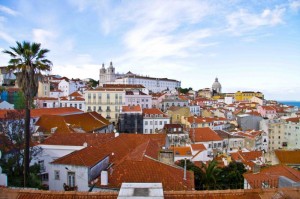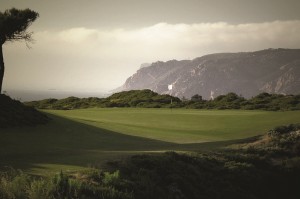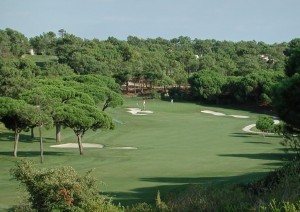
Overshadowed by its next-door neighbor Spain, as well as the rest of Europe, Portugal deserves more attention
Pity poor Portugal. Like a third-string quarterback, it rarely gets the good look, seldom a chance to strut its stuff. In European golf, Great Britain is the franchise player, Spain the backup. Lowly Portugal rides the bench, saying, “Play me or trade me.”
My advice? Play.
It’s not as if anyone is going to confuse the finest courses in Portugal—and there are quite a few good ones—with the classics of Scotland and Ireland. And it can be annoying difficult to get reliable information on where you should play, more proof that as a golf destination Portugal doesn’t get much respect. (The national tourist office is little help and the internet is thin on detail.) But there isn’t a great deal of difference between Portuguese prime and the best of neighboring Spain or the rest of the Continent. Plus there are many other qualities—great food, broad beaches, history and culture galore, ample sunshine—that should raise the stature of Iberia’s “other” country.
Most of Portugal’s 80 or so courses are concentrated in two areas: The Algarve, the country’s southern coast along the Atlantic; and near the capital city Lisbon, which is where a visit should begin with a day or two of exploration and eating.
 Like Rome, Lisbon (left) is built on seven hills, which can make driving and walking tiring and frustrating. But it’s easy to get re-exhilarated strolling the narrow cobblestoned streets and stopping in a cafe or restaurant for a strong coffee, cold beer (try the local lager, Super Bock), or a more substantial meal of today’s catch: Bordered on two sides by ocean, seafood in Portugal is plentiful and plenty good.
Like Rome, Lisbon (left) is built on seven hills, which can make driving and walking tiring and frustrating. But it’s easy to get re-exhilarated strolling the narrow cobblestoned streets and stopping in a cafe or restaurant for a strong coffee, cold beer (try the local lager, Super Bock), or a more substantial meal of today’s catch: Bordered on two sides by ocean, seafood in Portugal is plentiful and plenty good.
Each hill is topped by a castle, church, or other edifice that reveals expansive views over red roofs and the busy Tagus River. The most historic hill-topper is Saint George’s Castle, begun by the 5th-century Visigoths, annexed by the Moors, and now showcasing the city’s multicultural history. Walk down from the castle through the labyrinthine Alfama, the old Arab quarter, and dine in any of the outdoor restaurants that spill into the tiny streets and secluded plazas.
Only slightly less hilly than the capital, Oitavos Dunes (right), in Cascais, is a 10-year-old course designed by Arthur Hills that offers panoramas of its own—of ocean, mountains, and forest. Built through trees, over dunes, and atop rock bluffs in the Sintra-Cascais National Park an hour west of Lisbon, the course is one of the country’s best, with a tough back nine that has the high, seaside feel of Bandon Dunes. Still, I was surprised that Golf Magazine recently ranked Oitavos 88th on its list of the World’s Top 100: It’s good but not that good (there are too many straight, dull holes on the front nine), although the views are world-class.
 A luxury hotel recently opened next door, run by the Champalimaud family that also owns the course and the Quinta da Marinha resort. They’ve proven exceptional stewards of the land and tradition, so the hotel is sure to shine.
A luxury hotel recently opened next door, run by the Champalimaud family that also owns the course and the Quinta da Marinha resort. They’ve proven exceptional stewards of the land and tradition, so the hotel is sure to shine.
The short, hilly, tree-lined, Estoril Golf Club—in the nearby town of the same name—was designed in 1945 by Mackenzie Ross, who would later be responsible for Turnberry’s magnificent Ailsa course. This is not a links and there is no lighthouse, but squint a bit and Estoril almost feels like a British club both inside and out. The grand Hotel Palacio next door drips with old-world charm and is said to have been the model for Ian Fleming’s Casino Royale.
Also not far away is the Penha Longa Hotel and Golf Resort, featuring 27 holes from Robert Trent Jones Jr. The Atlantic course, frequent host of the Portuguese Open, begins in trees then opens up to broad, rolling terrain punctuated by water and sand. A far more interesting hazard is what remains of a 700-year-old aqueduct bordering the green of the double-dogleg par-five 6th hole.
The Algarve is a two-hour-plus drive on the modern (and fast—the Portuguese keep the pedal down!) A2 motorway. But don’t rush. Take the more leisurely route through the port of Setubal, catching the ferry to the Troia Peninsula, a spit of land between the Atlantic and the Sado River estuary with sensational beaches and the country’s toughest track, Troia Golf Club. Narrow fairways dogleg through pine trees and across dunes, finishing at small, well-guarded greens. When the Portuguese Open was played here in 1983, only one player, Sam Torrance, was able to break par. Off the beaten track, Troia is worth finding, although it’s suffered from half-hearted maintenance the last few years; be sure to play from the appropriate tees, especially if the wind is up.
Along the country’s southern edge, the Algarve is 100 miles of Atlantic beaches, fishing villages, lush valleys, and rocky cliffs. The region has been a crossroads of history: “Algarve” comes from the Arabic word for “the west,” as it was once the far end of the Muslim empire, and the many churches, castles, and other relics reflect centuries of cultures clashing and comingling. The most recent invaders have been British tourists, who descended on cheap charter flights rather than galleons and brought with them pubs, time-shares, and golf. Helping lead the charge was Sir Henry Cotton, one of England’s finest golfers and former Ryder Cup captain, who settled in the Algarve in the late 1950s and built a number of local courses, most notably Penina Golf Club.
Some of the early tracks—such as Penina, the Old Course at Vilamoura, the revamped Vale do Lobo (another Cotton design), and the nine-hole Pine Hill—are still worth playing and offer varying levels of challenge. A rung or two up the ladder is a handful of very strong, very enjoyable courses usually less than an hour’s drive from anywhere along the coast.
 There are three courses at Quinto do Lago, a sprawling estate of private villas (Madonna owns one), apartments, and water sports with the ocean on one side, a nature preserve on the other. The South course (left), which has also hosted the Portuguese Open, is the best of the three, rising, falling, and twisting through cork trees and other natural vegetation (it’s reminiscent of Spain’s Valderrama, which is only 150 miles to the east), the last few holes incorporating two large lakes. The course plays deceptively long thanks to sharp elevation changes, but accuracy is needed to avoid the thick stands of trees lining almost every hole. The North course is a less testing version of the South, while the newer Laranjal relies more on water and sand to defend itself. All three courses are kept in excellent condition.
There are three courses at Quinto do Lago, a sprawling estate of private villas (Madonna owns one), apartments, and water sports with the ocean on one side, a nature preserve on the other. The South course (left), which has also hosted the Portuguese Open, is the best of the three, rising, falling, and twisting through cork trees and other natural vegetation (it’s reminiscent of Spain’s Valderrama, which is only 150 miles to the east), the last few holes incorporating two large lakes. The course plays deceptively long thanks to sharp elevation changes, but accuracy is needed to avoid the thick stands of trees lining almost every hole. The North course is a less testing version of the South, while the newer Laranjal relies more on water and sand to defend itself. All three courses are kept in excellent condition.
Abutting Quinto do Lago, San Lorenzo spent many years near the top of Continental Europe’s best-course lists. Its opening holes navigate a thick pine forest then water replaces woods with a few holes along the Ria Formosa Estuary and much of the back nine wrapping around a large lake. The views are nearly as arresting as the course is tough, especially at the par-three fifth, which is the shortest hole on the course but looks out over the beach to the watery horizon. Unfortunately, here too maintenance issues sometimes detract from the experience, and slow play can be a problem.
There are no such drawbacks at Monte Rei, a three-year-old Jack Nicklaus design that tops my list of Portugal clubs as well as courses (and is the photograph at the top of this article). In the foothills of the Serra do Caldeirao mountains at the eastern end of the Algarve near the Spanish border, Monte Rei is a residential resort that puts the emphasis on service. Greens fees may be higher than at most other Portuguese courses, but the one payment includes many amenities such as range balls, yardage guide, and a cart, which is necessary as the course sprawls over the 1,000-acre resort and traverses the highland terrain. Somehow, Jack managed a feat of architectural optical illusion, sculpting numerous downhill holes while disguising any sense of playing uphill.
Big, bold, and exquisitely manicured, Monte Rei also tops Golf Digest’s ranking of Portuguese courses, and I expect it will turn up on more favorites’ lists soon. (Another Nicklaus course is planned on site, but probably will have to wait for local and international economies to improve.) Recognition is also sure to come to the club’s dining facilities, overseen by a chef who cut his teeth at El Bulli, a Michelin three-star restaurant in Spain.
As for recognition of Portugal in the minds of the world’s golfers? It, too, is just a matter of time.
An edited version of this article first appeared in the Winter 2010 issue of Colorado Avid Golfer magazine.
